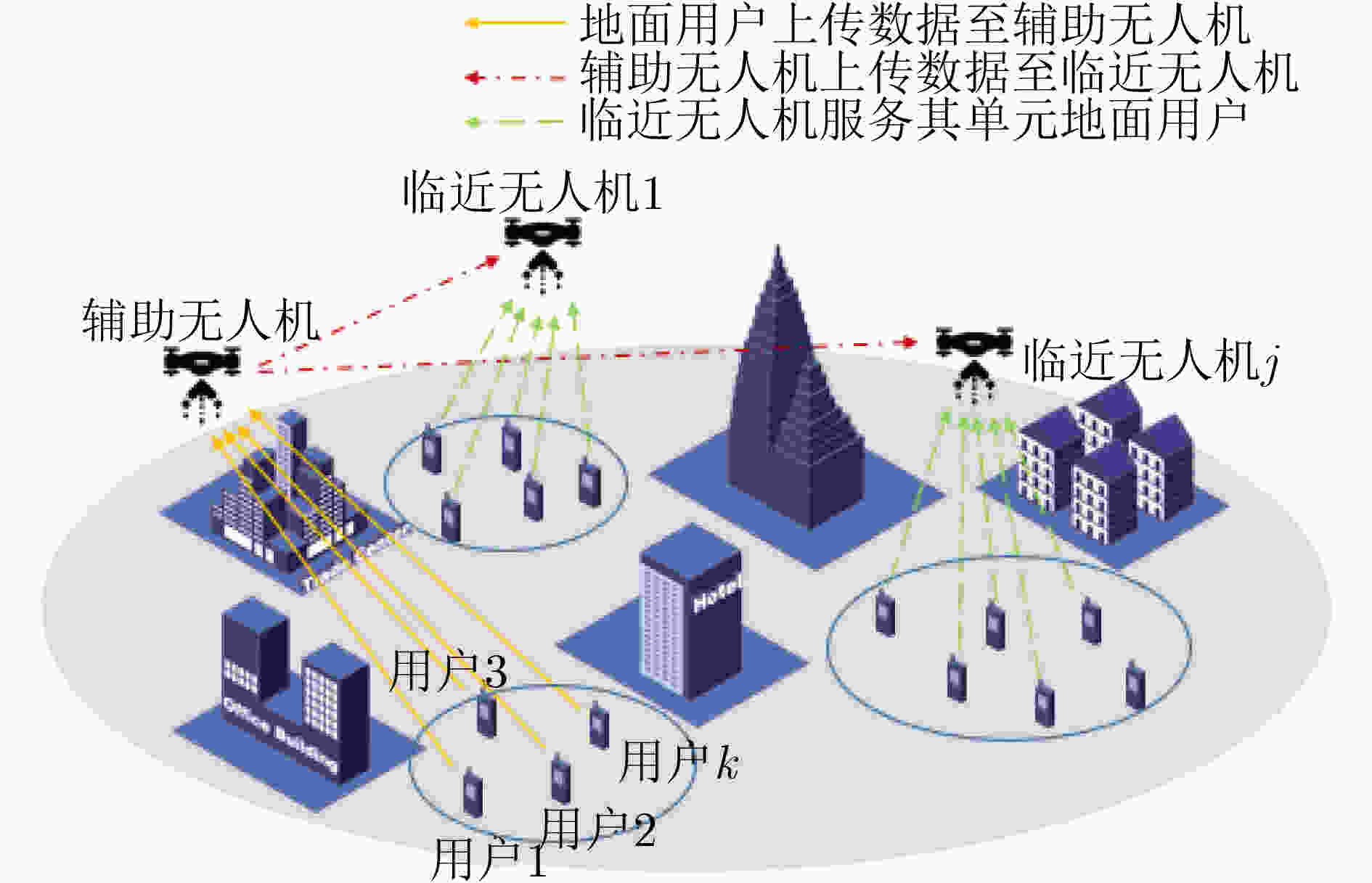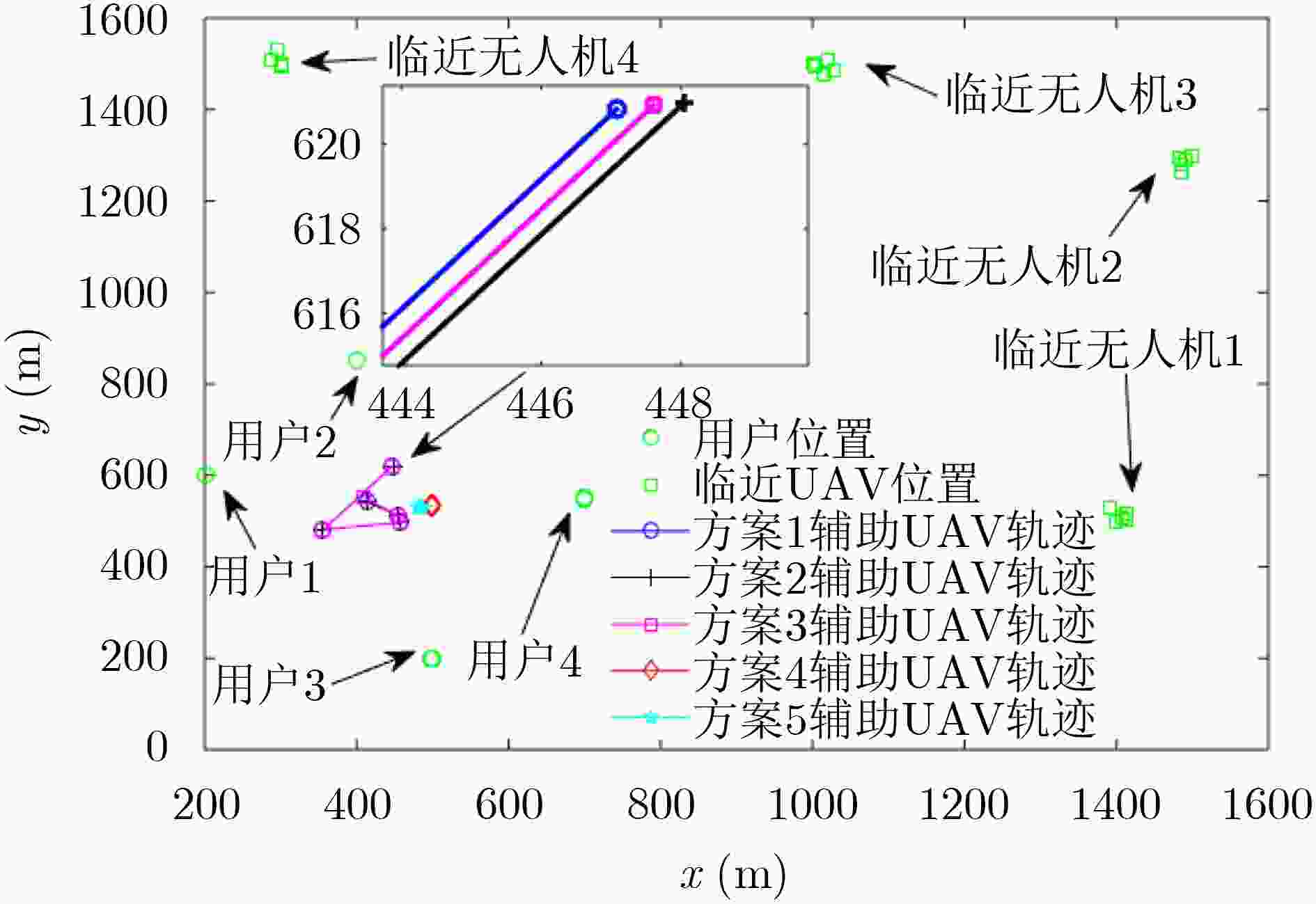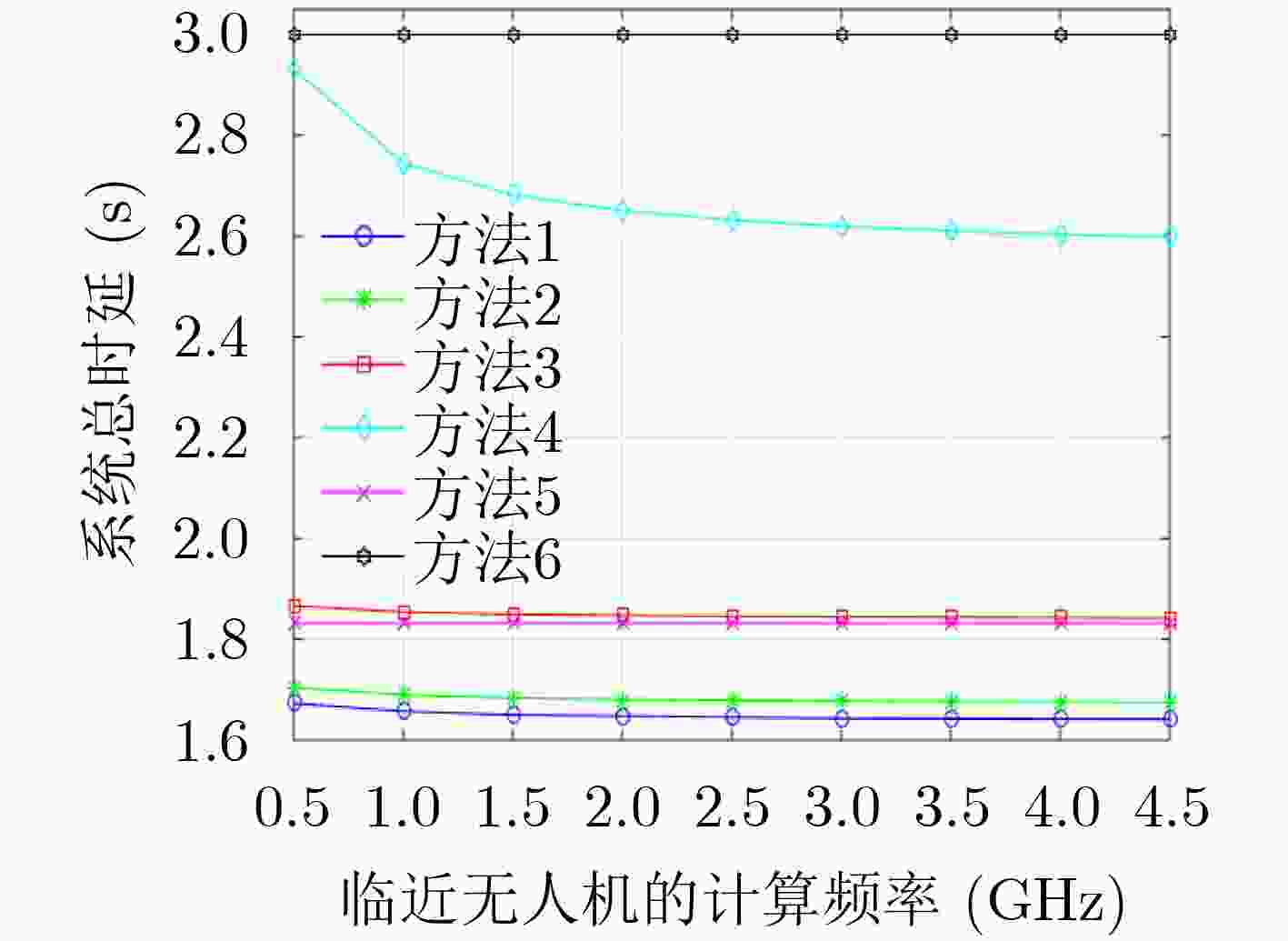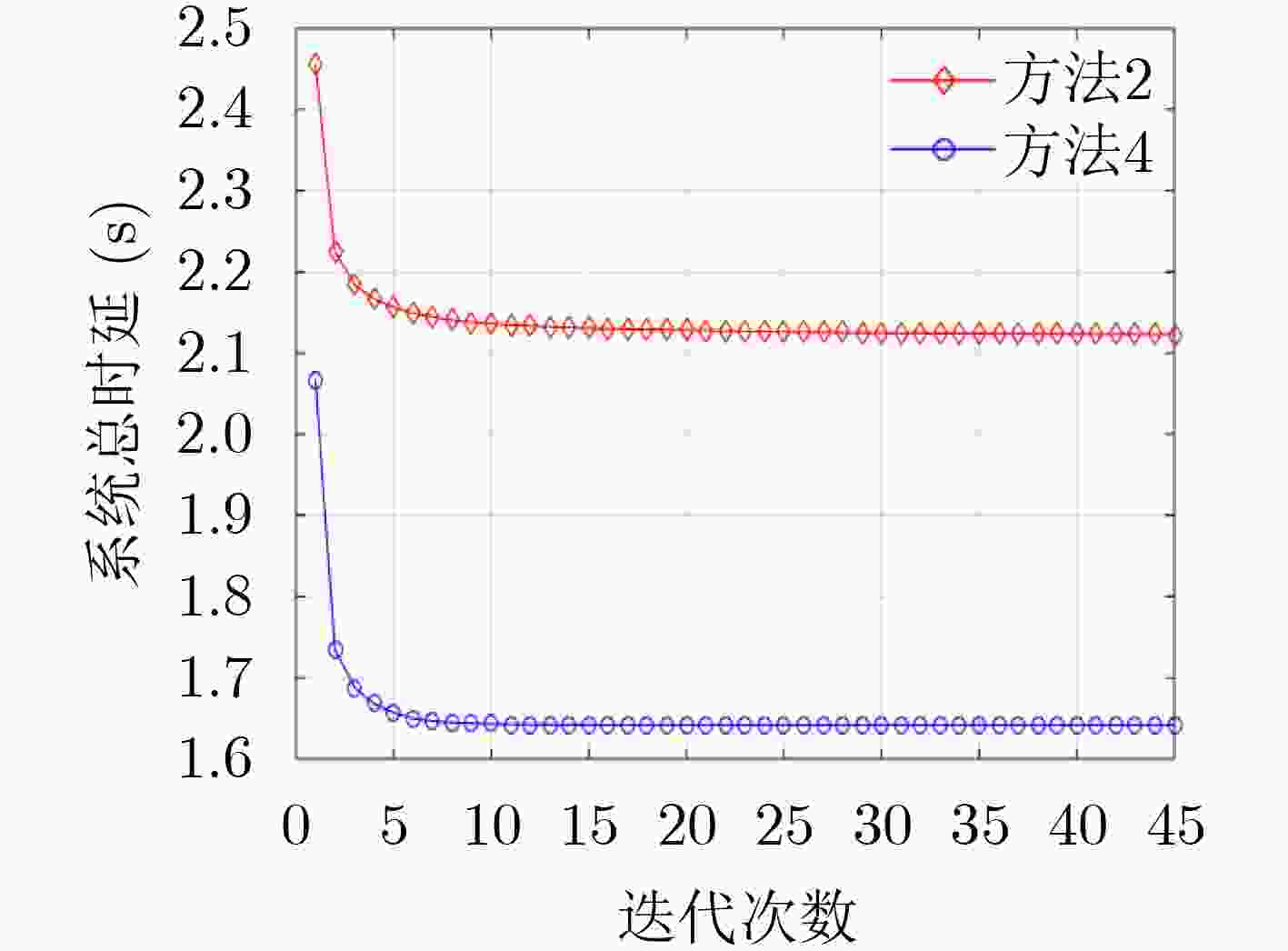Delay Optimization Design for Multi-UAVs Mobile Edge Computing Systems Based on MIMO
-
摘要: 物联网数据的快速增长和物联网设备的计算限制催生了移动边缘计算(Mobile Edge Computing, MEC)解决方案。其中,无人机群的高机动性、易部署以及成本低的特点和多输入多输出(Multiple Input Multiple Output, MIMO)技术能够增强边缘计算网络的传输容量,缩短边缘计算网络的传输时延。该文在基于多无人机的多用户MIMO-MEC系统中通过联合优化无人机轨迹、地面用户卸载比、辅助无人机卸载比和辅助无人机数据分发比最小化整个周期的系统最大总时延。采用了连续凸优化技术和块坐标下降方法来解决其中的非凸问题。仿真结果讨论了影响系统时延的因素,并验证了算法的有效性及收敛性。Abstract: The rapid growth of data and the computing limitations of devices have spawned Mobile Edge Computing (MEC) solutions in Internet of Things. Among them, the high maneuverability, easy deployment and low cost of the Unmanned Aerial Vehicle (UAV) swarm and Multiple Input Multiple Output (MIMO) technology can enhance the transmission capacity and shorten the transmission delay in the MEC network. In this paper, the maximum total delay of the system are minimized by jointly optimizing the UAV trajectory, ground users’ratio of data offloaded, assisted UAV’s ratio of data offloaded and assisted UAV’sratio of data allocation in the multi-UAVs MIMO-MEC system, in which successive convex optimization technology and block coordinate descent method are used to solve the non-convex problem. The factors affecting the system delay are discussed, and the effectiveness and convergence of the algorithm is verified in the simulation results.
-
Key words:
- UAV communication /
- Mobile Edge Computing (MEC) /
- MIMO /
- Trajectory optimization
-
表 1 针对问题式(25)的优化算法
算法1 问题式(27)的块坐标下降算法 1:初始化变量集合$\{ {{\boldsymbol{L}}^0},{\boldsymbol{M}}_1^0,{{\boldsymbol{b}}^0},{{\boldsymbol{Q}}^0}\} $. 使得l= 0. 2:repeat 3:给定$\{ {\boldsymbol{M}}_1^l,{{\boldsymbol{b}}^l},{{\boldsymbol{Q}}^l}\} $求解问题式(26),求解最优情况$\{ {{\boldsymbol{L}}^{l + 1}}\} $ 4:给定$\{ {{\boldsymbol{L}}^{l + 1}},{{\boldsymbol{b}}^l},{{\boldsymbol{Q}}^l}\} $求解问题式(27),求解最优情况$\{ {\boldsymbol{M}}_1^{l + 1}\} $ 5:给定$\{ {{\boldsymbol{L}}^{l + 1}},{\boldsymbol{M}}_1^{l + 1},{{\boldsymbol{Q}}^l}\} $求解问题式(28),求解最优情况
$\{ {{\boldsymbol{b}}^{l + 1}}\} $6:给定$\{ {{\boldsymbol{L}}^{l + 1}},{\boldsymbol{M}}_1^{l + 1},{{\boldsymbol{b}}^{l + 1}}\} $求解问题式(34),求解最优情况
$\{ {{\boldsymbol{Q}}^{l + 1}}\} $7:更新l= l + 1. 8:until目标函数的增益小于一个阈值$ \varepsilon > 0 $. 表 2 部分仿真参数列表
参数 参数数值 参数 参数数值 $ {B_{{\text{user}},k}} $ $ 1\;{\text{MHz}} $ $ {B_{{\text{UAV,}}w}} $ $ 1\;{\text{MHz}} $ ${{{D}}_k}[n]$ $3 \times {10^5}\;{\text{bit}}$ ${l_k}[n]$ $0.5\forall k,n$ ${m_1}[n]$ $0.5\forall n$ ${b_j}[n]$ $0.25\forall j,n$ ${c_k}$ $ {10^3} \; {\text{cycle/bit}} $ ${c_{{\text{UAV}}}}$${c_{{\text{near}},j}}$ $ 5 \times {10^2}\; {\text{cycle/bit}}$ $ {f_{{\text{user}},k}} $ ${\text{0}}{\text{.5 GHz}}$ ${f_{{\text{UAV}}}}$ ${\text{4 GHz}}$ ${a_k}$ ${10^{ - 27}}$ ${a_{{\text{UAV}}}}$${a_{{\text{near}},j}}$ ${10^{ - 27}}$ ${p_k}[n]$ $ 0.01\;{\text{W}}, \forall k,n $ ${p_j}[n]$ $ 0.0125\;{\text{W}}, \forall j,n $ $ \sigma _{j,k}^2[n] $ $ - 130\;{\text{dBm}}, \forall j,k,n $ ${ {{V} }_{\max } }$ $ 50\;{\text{m/s}} $ $ {\rho _0} $ $ - 60\;{\text{dB}} $ $ \varepsilon $ $ {10^{ - 4}} $ ${{{E}}_1}$ $3.6\;{\text{kJ}}$ ${{{E}}_2}$ $360\;{\text{kJ}}$ ${{{E}}_3}$ $36\;{\text{kJ}}$ ${{{M}}_{{\text{UAV}}}}$ $9.65\;{\text{kg}}$ 表 3 5种方案的用户、辅助无人机、临近无人机计算数据量和系统总延迟对比
方案 用户计算数
据量(bit)辅助无人机计算
数据量(bit)临近无人机计算
数据量(bit)系统总延
迟(s)1 4250114 1146772 603114 2.1251 2 4244491 1133592 621917 2.12223 3 42411928 11356814 6231258 21.2060 4 3282420 1718374 999206 1.6412 5 32810611 17276719 9912670 16.4053 表 4 5种方案的各临近无人机计算量对比(时刻n=1)
方案 无人机1(bit) 无人机2(bit) 无人机3(bit) 无人机4(bit) 1 44850 28512 39401 50602 2 46543 29047 40617 52762 3 465139 290337 406029 527704 4 63817 35376 46059 54784 5 625691 349530 457020 551674 -
[1] ZHANG Shangwei, LIU Jiajia, and SUN Wen. Stochastic geometric analysis of multiple unmanned aerial vehicle-assisted communications over internet of things[J]. IEEE Internet of Things Journal, 2019, 6(3): 5446–5460. doi: 10.1109/JIOT.2019.2902162 [2] YUAN Zhenhui, JIN Jie, SUN Lingling, et al. Ultra-reliable IoT communications with UAVs: A swarm use case[J]. IEEE Communications Magazine, 2018, 56(12): 90–96. doi: 10.1109/MCOM.2018.1800161 [3] HAYAT S, YANMAZ E, and MUZAFFAR R. Survey on unmanned aerial vehicle networks for civil applications: A communications viewpoint[J]. IEEE Communications Surveys & Tutorials, 2016, 18(4): 2624–2661. doi: 10.1109/COMST.2016.2560343 [4] VALCARCE A, RASHEED T, GOMEZ K, et al. Airborne base stations for emergency and temporary events[C]. Proceedings of the 5th International Conference on Personal Satellite Services, Toulouse, Fracne, 2013: 13–25. [5] ZENG Yong, ZHANG Rui, and TENG J L. Wireless communications with unmanned aerial vehicles: Opportunities and challenges[J]. IEEE Communications Magazine, 2016, 54(5): 36–42. doi: 10.1109/MCOM.2016.7470933 [6] JEONG S, SIMEONE O, and KANG J. Mobile edge computing via a UAV-mounted cloudlet: Optimization of bit allocation and path planning[J]. IEEE Transactions on Vehicular Technology, 2018, 67(3): 2049–2063. doi: 10.1109/TVT.2017.2706308 [7] ZHANG Tiankui, XU Yu, LOO J, et al. Joint computation and communication design for UAV-assisted mobile edge computing in IoT[J]. IEEE Transactions on Industrial Informatics, 2020, 16(8): 5505–5516. doi: 10.1109/TII.2019.2948406 [8] MAO Yuyi, YOU Changsheng, ZHANG JUN, et al. A survey on mobile edge computing: The communication perspective[J]. IEEE Communications Surveys & Tutorials, 2017, 19(4): 2322–2358. doi: 10.1109/COMST.2017.2745201 [9] HU Qiyu, CAI Yunlong, YU Guanding, et al. Joint offloading and trajectory design for UAV-enabled mobile edge computing systems[J]. IEEE Internet of Things Journal, 2019, 6(2): 1879–1892. doi: 10.1109/JIOT.2018.2878876 [10] YU Zhe, GONG Yanmin, GONG Shimin, et al. Joint task offloading and resource allocation in UAV-enabled mobile edge computing[J]. IEEE Internet of Things Journal, 2020, 7(4): 3147–3159. doi: 10.1109/JIOT.2020.2965898 [11] MEI Haibo, YANG Kun, LIU Qiang, et al. Joint trajectory-resource optimization in UAV-enabled edge-cloud system with virtualized mobile clone[J]. IEEE Internet of Things Journal, 2020, 7(7): 5906–5921. doi: 10.1109/JIOT.2019.2952677 [12] ZHANG Liang and ANSARI N. Latency-aware IoT service provisioning in UAV-aided mobile-edge computing networks[J]. IEEE Internet of Things Journal, 2020, 7(10): 10573–10580. doi: 10.1109/JIOT.2020.3005117 [13] SHI Qingjiang, PENG Cheng, XU Weiqiang, et al. Energy efficiency optimization for MISO SWIPT systems with zero-forcing beamforming[J]. IEEE Transactions on Signal Processing, 2016, 64(4): 842–854. doi: 10.1109/TSP.2015.2489603 [14] CHO Y S, KIM J, YANG W Y, 等, 孙锴, 黄威, 译. MIMO-OFDM无线通信技术及MATLAB实现[M]. 北京: 电子工业出版社, 2013.CHO Y S, KIM J, YANG W Y, et al. , SUN Kai, HUANG Wei, trans. MIMO-OFDM Wireless Communications with MATLAB[M]. Beijing: Publishing House of Electronics Industry, 2013. [15] WU Qingqing, ZENG Yong, and ZHANG Rui. Joint trajectory and communication design for multi-UAV enabled wireless networks[J]. IEEE Transactions on Wireless Communications, 2018, 17(3): 2109–2121. doi: 10.1109/TWC.2017.2789293 -






 下载:
下载:





 下载:
下载:
